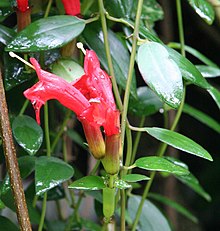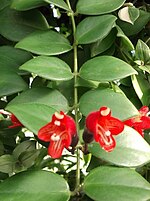
Toxicodendron radicans, commonly known as eastern poison ivy or poison ivy, is a species of allergenic flowering plant. It has numerous subtaxons and forms both vines and shrubs. Despite its common name, it is not a true ivy, but rather a member of the cashew and pistachio family Anacardiaceae. It is different from western poison ivy, Toxicodendron rydbergii, and resembles a number of species.

Campsis radicans, the trumpet vine, yellow trumpet vine, or trumpet creeper, is a species of flowering plant in the trumpet vine family Bignoniaceae, native to eastern North America, and naturalized elsewhere. Growing to 10 metres, it is a vigorous, deciduous woody vine, notable for its showy trumpet-shaped flowers. It inhabits woodlands and riverbanks, and is also a popular garden plant.

Alstroemeriaceae is a family of flowering plants, with 254 known species in four genera, almost entirely native to the Americas, from Central America to southern South America. One species of Luzuriaga occurs in New Zealand, and the genus Drymophila is endemic to south-eastern Australia.

Aeschynanthus is a genus of about 150 species of evergreen subtropical and tropical plants in the family Gesneriaceae. They are usually trailing epiphytes with brightly colored flowers that are pollinated by sunbirds. The genus name comes from a contraction of aischuno and anthos (flower). The common name for some species is lipstick plant, which comes from the appearance of the developing buds emerging from the calyces. A full list of the accepted species and their synonyms can be found in the Smithsonian Institution's World Checklist of Gesneriaceae.

Cleistocactus strausii, the silver torch or wooly torch, is a perennial flowering plant in the family Cactaceae. It is native to mountainous regions of Department Tarija, Bolivia, at 1,500–3,000 m (4,921–9,843 ft).

Epidendrum radicans is a species of orchid native to Central America and northern South America. Common names include ground-rooting epidendrum, fire-star orchid, crucifix orchid, rainbow orchid, and reed-stem epidendrum.

Lobelia cardinalis, the cardinal flower, is a species of flowering plant in the bellflower family Campanulaceae native to the Americas, from southeastern Canada south through the eastern and southwestern United States, Mexico and Central America to northern Colombia.

Hesperantha coccinea, the river lily, or crimson flag lily, synonym Schizostylis coccinea, is a species of flowering plant in the iris family Iridaceae, native to Southern Africa and Zimbabwe. It is a semievergreen perennial growing to 60 cm (24 in) tall, with slender lanceolate leaves up to 40 cm (16 in) long and 1 cm (0.4 in) broad. The flowers are red, occasionally pink or white, 30–35 mm long, with six petals; they are produced four to ten alternately on a spike in late summer to autumn.

Erythrina lysistemon is a species of deciduous tree in the pea family, Fabaceae. It is native to South Africa. Common names include common coral-tree, lucky bean tree, umsintsi (Xhosa), muvhale (Venda), mophete (Tswana), koraalboom of kanniedood (Afrikaans), mokhungwane (Sotho) and mutiti (Shona). It is regularly cultivated as a tree for gardens and parks.

Ipomoea nil is a species of Ipomoea morning glory known by several common names, including picotee morning glory, ivy morning glory, ivy-leaf morning glory, and Japanese morning glory. It is native to the tropical Americas, and has been introduced widely across the world.

Prunus tomentosa is a species of Prunus native to northern and western China, Korea, Mongolia, and possibly northern India. Common names for Prunus tomentosa include Nanjing cherry, Korean cherry, Manchu cherry, downy cherry, Shanghai cherry, Ando cherry, mountain cherry, Chinese bush cherry, and Chinese dwarf cherry.
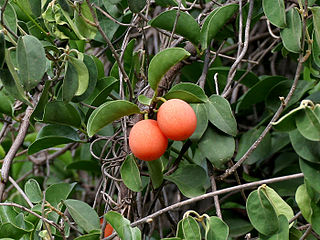
Ximenia americana, commonly known as tallow wood, hog plum, yellow plum, sea lemon, or pi'ut (Chamorro), is bush-forming shrub/small tree; a species from the Ximenia genus in the Olacaceae family. It is mainly found in the tropics, ranging from Africa, India and southeast Asia, to Australia, New Zealand, Pacific Islands, West Indies, Central, North and South America. It is especially common in Africa and South America. It is not domesticated so it is only found occurring in the wild.
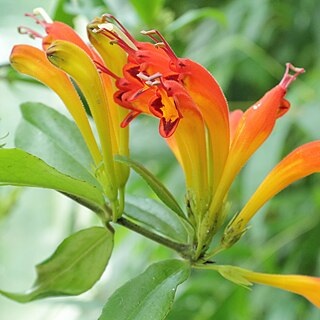
Aeschynanthus speciosus, also known as the basket plant, is a species of flowering plant in the family Gesneriaceae. There are many species of Aeschynanthus, all of which have long, trailing stems and bright flowers. The large, fleshy, dark green leaves are up to 10 cm (4 in) long and 4 cm wide and are arranged in groups along the stems. The flowers can be as long as 10 cm (4 in) and grow in clusters that usually consist of 6–20 flowers. Most of the time they are shaded in different colors, from orange–yellow in the lower area to orange–red at the tip with a blotched red inside and a yellow streaked throat.

Aeschynanthus pulcher, the lipstick plant or red bugle vine, is a species of evergreen perennial plant in the family Gesneriaceae, native to Indochina and western Malesia. An epiphytic climber, it produces clusters of red flowers from summer to winter. The common name "lipstick plant" refers to the bright red tubular flowers, about 6 cm long, that emerge from a maroon calyx, which resemble lipstick emerging from a tube. The plant may grow 60 cm to 2 meters tall, with an average spread of 50 cm. The leaves are elliptic and are arranged in pairs, with smooth edges.

Phaleria capitata is a species of flowering plant in the family Thymelaeaceae. It grows as a shrub or small tree up to 10 metres (30 ft) tall, with a stem diameter of up to 15 centimetres (6 in). Twigs are reddish brown. Inflorescences usually bear five flowers. The fruits are roundish, up to 1.5 cm (1 in) long. Habitat is forest from sea-level to 1,200 metres (3,900 ft) altitude. P. capitata grows naturally in Sri Lanka, Peninsular Malaysia, Sumatra, Borneo, Sulawesi, Maluku, the Philippines, New Guinea, the Caroline Islands and Tonga.

Mimetes hottentoticus is an evergreen, upright shrub of 1½–3 m (5–10 ft) high from the family Proteaceae. It has silvery, broadly egg-shaped to egg-shaped leaves with three small teeth crowded at the tip. The flower heads and subtending leaves form a cylindric inflorescence, topped with a tuft of smaller, more or less upright silvery or pinkish leaves. Each flowerhead contains 8–12 flowers with conspicuously red styles, that are all parallel, projected straight up, pushing against the leaf subtending the higher flowerhead. The styles end in a short white zone topped by a thick blackish pollen presenter. Flowers can usually be found from January till March, few may persist into May. It is called silver pagoda or matchstick pagoda in English and Hottentotstompie in Afrikaans.

Mimetes stokoei, the mace pagoda, is an evergreen, upright, hardly branching, large shrub of 1–2 m high in the family Proteaceae. It has silvery, oval leaves of 5–8 cm (2.0–3.2 in) long and 2+1⁄2–4 cm (1.0–1.6 in) wide, with one large tooth supported by two smaller teeth near the tip, at an upward angle and somewhat overlapping each other. The inflorescences are set just below the growing tip, are cylinder-shaped, 10–12 cm (4–5 in) high, topped by a crest of small, more or less horizontal, pinkish-purple tinged leaves. It consists of several flower heads in the axils of golden leaves with a pinkish wash that form a hood shielding the underlying flower head. Each flower head contains eight to twelve individual flowers, with amber-colored styles topped by blackish purple pollen presenters and grey silky perianth lobes. It is endemic to the Fynbos ecoregion of South Africa, being confined to the Kogelberg mountain range. The mace pagoda was twice presumed extinct, but reappeared in its natural habitat from seed, after a wildfire several decades later.
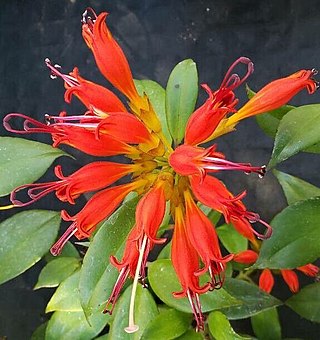
Aeschynanthus fulgens is an Asian species of plants in the family Gesneriaceae and tribe Trichosporeae, with no subspecies listed in the Catalogue of Life. A common name for this and similar species in the genus is "lipstick vine"; its name in Vietnamese is má dào Everard.
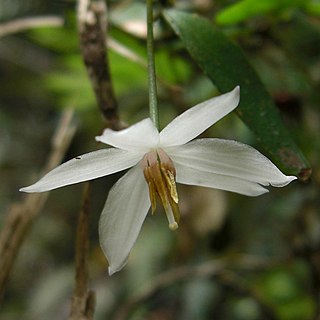
Luzuriaga radicans is a species of flowering plant in the genus Luzuriaga of the family Alstroemeriaceae (Inca-lilies), part of the monocot order Liliales. It is native to Chile and Argentina.

Nematanthus gregarius, also called the clog plant or goldfish plant, is a species of flowering plant from Brazil in the gesneriad family, Gesneriaceae, making it a relative of such genera as Streptocarpus and Aeschynanthus.
